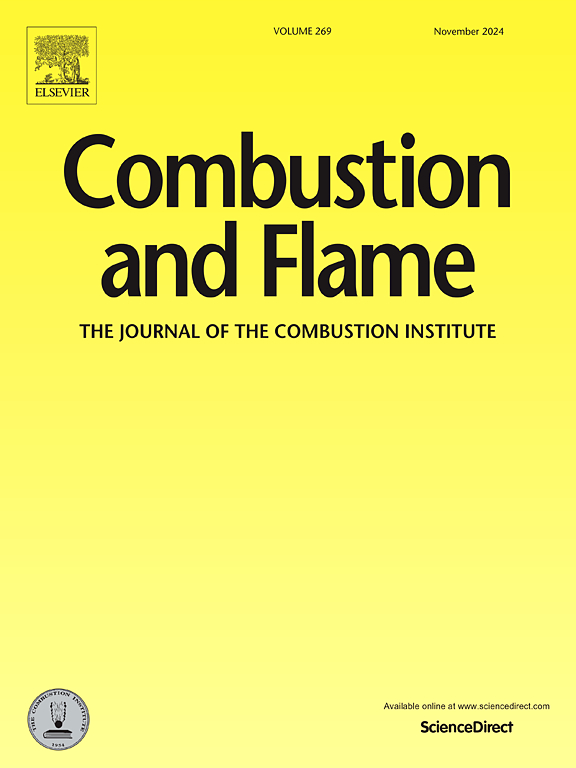UnblindMix:用于高温燃烧诊断中多组分检测的无监督参考框架
IF 6.2
2区 工程技术
Q2 ENERGY & FUELS
引用次数: 0
摘要
高温燃烧过程的特点是快速形成和消耗大量的反应物质,对准确的诊断测量提出了实质性的挑战。传统的方法通常需要耗费大量的劳动来收集高温吸收截面光谱,这限制了可扩展性和效率。为了解决这些挑战,我们提出了UnblindMix,这是一个无监督、无参考的诊断框架,利用盲源分离(BSS)同时推断物种浓度,并直接从复合混合物光谱中重建高温参考光谱。本研究证明了UnblindMix在923 K和1atm下正丁烷和异丁烷的热解实验以及高温静态电池中C1−C3烃的非反应性混合物中的能力。该模型使用工作在2984.5-2989.5 cm−1范围内的带间级联激光器(ICL),准确地预测了时间分辨的物种分布,并在对已有光谱数据库的最小依赖下重建了高温参考光谱。通过对AramcoMech 3.0仿真和实验数据的验证,结果吻合较好。UnblindMix代表了吸收诊断的重大进步,减少了对广泛光谱数据库的依赖,并为实验室和工业应用中的多物种检测提供了可扩展、高效的解决方案。新颖性和意义本研究的新颖之处在于引入了UnblindMix,这是一种基于自编码器的盲源分离模型,能够推断物质浓度并仅从混合光谱重建高温参考光谱。它的意义重大,因为它消除了对劳动密集型高温吸收截面数据集的依赖,为燃烧诊断中的多物种检测提供了可扩展和强大的框架。该模型在正丁烷和异丁烷实时热解中的应用表明,它有可能为研究和工业应用带来革命性的高温光谱分析。本文章由计算机程序翻译,如有差异,请以英文原文为准。
UnblindMix: An unsupervised reference-free framework for multi-species detection in high-temperature combustion diagnostics
High-temperature combustion processes are characterized by the rapid formation and consumption of numerous reactive species, presenting substantial challenges for accurate diagnostic measurements. Traditional approaches often require labor-intensive collection of high-temperature absorption cross-section spectra, which limits scalability and efficiency. To address these challenges, we present UnblindMix, an unsupervised, reference-free diagnostic framework that leverages blind source separation (BSS) to simultaneously infer species concentrations and reconstruct high-temperature reference spectra directly from composite mixture spectra. This study demonstrates the capability of UnblindMix in pyrolysis experiments of n-butane and iso-butane at 923 K and 1 atm, as well as in non-reactive mixtures of hydrocarbons in a high-temperature static cell. Using an interband cascade laser (ICL) operating over 2984.5–2989.5 cm−1 range, the model accurately predicts time-resolved species profiles and reconstructs high-temperature reference spectra with minimal reliance on pre-existing spectral databases. Validation against AramcoMech 3.0 simulations and experimental data revealed good agreement. UnblindMix represents a significant advancement absorption diagnostics, reducing the dependency on extensive spectral databases and offering a scalable, efficient solution for multi-species detection in laboratory and industrial applications.
Novelty and significance
The novelty of this research lies in the introduction of UnblindMix, an autoencoder-based blind source separation model capable of inferring species concentrations and reconstructing high-temperature reference spectra solely from mixture spectra. It is significant because it eliminates the reliance on labor-intensive high-temperature absorption cross-section datasets, providing a scalable and robust framework for multi-species detection in combustion diagnostics. The model’s application to real-time pyrolysis of n-butane and iso-butane demonstrates its potential to revolutionize high-temperature spectroscopic analysis for both research and industrial applications.
求助全文
通过发布文献求助,成功后即可免费获取论文全文。
去求助
来源期刊

Combustion and Flame
工程技术-工程:化工
CiteScore
9.50
自引率
20.50%
发文量
631
审稿时长
3.8 months
期刊介绍:
The mission of the journal is to publish high quality work from experimental, theoretical, and computational investigations on the fundamentals of combustion phenomena and closely allied matters. While submissions in all pertinent areas are welcomed, past and recent focus of the journal has been on:
Development and validation of reaction kinetics, reduction of reaction mechanisms and modeling of combustion systems, including:
Conventional, alternative and surrogate fuels;
Pollutants;
Particulate and aerosol formation and abatement;
Heterogeneous processes.
Experimental, theoretical, and computational studies of laminar and turbulent combustion phenomena, including:
Premixed and non-premixed flames;
Ignition and extinction phenomena;
Flame propagation;
Flame structure;
Instabilities and swirl;
Flame spread;
Multi-phase reactants.
Advances in diagnostic and computational methods in combustion, including:
Measurement and simulation of scalar and vector properties;
Novel techniques;
State-of-the art applications.
Fundamental investigations of combustion technologies and systems, including:
Internal combustion engines;
Gas turbines;
Small- and large-scale stationary combustion and power generation;
Catalytic combustion;
Combustion synthesis;
Combustion under extreme conditions;
New concepts.
 求助内容:
求助内容: 应助结果提醒方式:
应助结果提醒方式:


